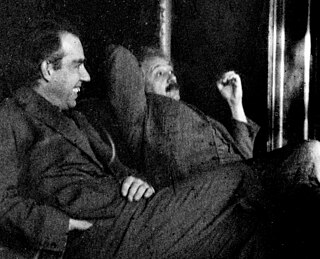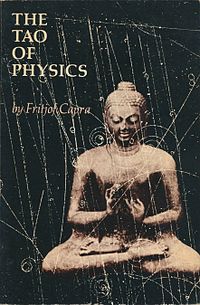Related Research Articles
The Copenhagen interpretation is a collection of views about the meaning of quantum mechanics, stemming from the work of Niels Bohr, Werner Heisenberg, Max Born, and others. While "Copenhagen" refers to the Danish city, the use as an "interpretation" was apparently coined by Heisenberg during the 1950s to refer to ideas developed in the 1925–1927 period, glossing over his disagreements with Bohr. Consequently, there is no definitive historical statement of what the interpretation entails.

The many-worlds interpretation (MWI) is a philosophical position about how the mathematics used in quantum mechanics relates to physical reality. It asserts that the universal wavefunction is objectively real, and that there is no wave function collapse. This implies that all possible outcomes of quantum measurements are physically realized in some "world" or universe. In contrast to some other interpretations, the evolution of reality as a whole in MWI is rigidly deterministic and local. Many-worlds is also called the relative state formulation or the Everett interpretation, after physicist Hugh Everett, who first proposed it in 1957. Bryce DeWitt popularized the formulation and named it many-worlds in the 1970s.

Niels Henrik David Bohr was a Danish physicist who made foundational contributions to understanding atomic structure and quantum theory, for which he received the Nobel Prize in Physics in 1922. Bohr was also a philosopher and a promoter of scientific research.

In quantum mechanics, Schrödinger's cat is a thought experiment, sometimes described as a paradox, of quantum superposition. In the thought experiment, a hypothetical cat may be considered simultaneously both alive and dead, while it is unobserved in a closed box, as a result of its fate being linked to a random subatomic event that may or may not occur. This thought experiment was devised by physicist Erwin Schrödinger in 1935 in a discussion with Albert Einstein to illustrate what Schrödinger saw as the problems of the Copenhagen interpretation of quantum mechanics.
An interpretation of quantum mechanics is an attempt to explain how the mathematical theory of quantum mechanics might correspond to experienced reality. Although quantum mechanics has held up to rigorous and extremely precise tests in an extraordinarily broad range of experiments, there exist a number of contending schools of thought over their interpretation. These views on interpretation differ on such fundamental questions as whether quantum mechanics is deterministic or stochastic, local or non-local, which elements of quantum mechanics can be considered real, and what the nature of measurement is, among other matters.
In physics, a correspondence principle is any one of several premises or assertions about the relationship between classical and quantum mechanics. The physicist Niels Bohr coined the term in 1920 during the early development of quantum theory; he used it to explain how quantized classical orbitals connect to quantum radiation. Modern sources often use the term for the idea that the behavior of systems described by quantum theory reproduces classical physics in the limit of large quantum numbers: for large orbits and for large energies, quantum calculations must agree with classical calculations. A "generalized" correspondence principle refers to the requirement for a broad set of connections between any old and new theory.
In quantum mechanics, wave function collapse, also called reduction of the state vector, occurs when a wave function—initially in a superposition of several eigenstates—reduces to a single eigenstate due to interaction with the external world. This interaction is called an observation, and is the essence of a measurement in quantum mechanics, which connects the wave function with classical observables such as position and momentum. Collapse is one of the two processes by which quantum systems evolve in time; the other is the continuous evolution governed by the Schrödinger equation.
In philosophy, the philosophy of physics deals with conceptual and interpretational issues in modern physics, many of which overlap with research done by certain kinds of theoretical physicists. Historically, philosophers of physics have engaged with questions such as the nature of space, time, matter and the laws that govern their interactions, as well as the epistemological and ontological basis of the theories used by practicing physicists. The discipline draws upon insights from various areas of philosophy, including metaphysics, epistemology, and philosophy of science, while also engaging with the latest developments in theoretical and experimental physics.
Physics and Beyond is a book by Werner Heisenberg, the German physicist who discovered the uncertainty principle. It tells, from his point of view, the history of exploring atomic science and quantum mechanics in the first half of the 20th century.
In physics, a hidden-variable theory is a deterministic physical model which seeks to explain the probabilistic nature of quantum mechanics by introducing additional variables.
In quantum mechanics, the measurement problem is the problem of definite outcomes: quantum systems have superpositions but quantum measurements only give one definite result.

The Bohr–Einstein debates were a series of public disputes about quantum mechanics between Albert Einstein and Niels Bohr. Their debates are remembered because of their importance to the philosophy of science, insofar as the disagreements—and the outcome of Bohr's version of quantum mechanics becoming the prevalent view—form the root of the modern understanding of physics. Most of Bohr's version of the events held in the Solvay Conference in 1927 and other places was first written by Bohr decades later in an article titled, "Discussions with Einstein on Epistemological Problems in Atomic Physics". Based on the article, the philosophical issue of the debate was whether Bohr's Copenhagen interpretation of quantum mechanics, which centered on his belief of complementarity, was valid in explaining nature. Despite their differences of opinion and the succeeding discoveries that helped solidify quantum mechanics, Bohr and Einstein maintained a mutual admiration that was to last the rest of their lives.

The Tao of Physics: An Exploration of the Parallels Between Modern Physics and Eastern Mysticism is a 1975 book by physicist Fritjof Capra. A bestseller in the United States, it has been translated into 23 languages. Capra summarized his motivation for writing the book: “Science does not need mysticism and mysticism does not need science. But man needs both.”
In physics, complementarity is a conceptual aspect of quantum mechanics that Niels Bohr regarded as an essential feature of the theory. The complementarity principle holds that certain pairs of complementary properties cannot all be observed or measured simultaneously, for examples, position and momentum or wave and particle properties. In contemporary terms, complementarity encompasses both the uncertainty principle and wave-particle duality.
Classical Newtonian physics has, formally, been replaced by quantum mechanics on the small scale and relativity on the large scale. Because most humans continue to think in terms of the kind of events we perceive in the human scale of daily life, it became necessary to provide a new philosophical interpretation of classical physics. Classical mechanics worked extremely well within its domain of observation but made inaccurate predictions at very small scale – atomic scale systems – and when objects moved very fast or were very massive. Viewed through the lens of quantum mechanics or relativity, we can now see that classical physics, imported from the world of our everyday experience, includes notions for which there is no actual evidence. For example, one commonly held idea is that there exists one absolute time shared by all observers. Another is the idea that electrons are discrete entities like miniature planets that circle the nucleus in definite orbits.

Quantum mysticism, sometimes referred pejoratively to as quantum quackery or quantum woo, is a set of metaphysical beliefs and associated practices that seek to relate consciousness, intelligence, spirituality, or mystical worldviews to the ideas of quantum mechanics and its interpretations. Quantum mysticism is considered pseudoscience and quackery by quantum mechanics experts.
The history of quantum mechanics is a fundamental part of the history of modern physics. The major chapters of this history begin with the emergence of quantum ideas to explain individual phenomena—blackbody radiation, the photoelectric effect, solar emission spectra—an era called the Old or Older quantum theories. Building on the technology developed in classical mechanics, the invention of wave mechanics by Erwin Schrödinger and expansion by many others triggers the "modern" era beginning around 1925. Paul Dirac's relativistic quantum theory work lead him to explore quantum theories of radiation, culminating in quantum electrodynamics, the first quantum field theory. The history of quantum mechanics continues in the history of quantum field theory. The history of quantum chemistry, theoretical basis of chemical structure, reactivity, and bonding, interlaces with the events discussed in this article.
In physics, the observer effect is the disturbance of an observed system by the act of observation. This is often the result of utilizing instruments that, by necessity, alter the state of what they measure in some manner. A common example is checking the pressure in an automobile tire, which causes some of the air to escape, thereby changing the pressure to observe it. Similarly, seeing non-luminous objects requires light hitting the object to cause it to reflect that light. While the effects of observation are often negligible, the object still experiences a change. This effect can be found in many domains of physics, but can usually be reduced to insignificance by using different instruments or observation techniques.
The von Neumann–Wigner interpretation, also described as "consciousness causes collapse", is an interpretation of quantum mechanics in which consciousness is postulated to be necessary for the completion of the process of quantum measurement.

Quantum Reality is a 1985 popular science book by physicist Nick Herbert, a member of the Fundamental Fysiks Group which was formed to explore the philosophical implications of quantum theory. The book attempts to address the ontology of quantum objects, their attributes, and their interactions, without reliance on advanced mathematical concepts. Herbert discusses the most common interpretations of quantum mechanics and their consequences in turn, highlighting the conceptual advantages and drawbacks of each.
References
- 1 2 Schlosshauer, Maximilian; Kofler, Johannes; Zeilinger, Anton (2013-08-01). "A snapshot of foundational attitudes toward quantum mechanics". Studies in History and Philosophy of Science Part B. 44 (3): 222–230. arXiv: 1301.1069 . Bibcode:2013SHPMP..44..222S. doi:10.1016/j.shpsb.2013.04.004. S2CID 55537196.
- ↑ Rieffel, Eleanor G.; Polak, Wolfgang H. (2011-03-04). Quantum Computing: A Gentle Introduction. MIT Press. ISBN 978-0-262-01506-6.
- ↑ Jammer, Max (1974). The Philosophy of Quantum Mechanics. John Wiley and Sons. ISBN 0-471-43958-4.
- ↑ Werner Heisenberg, Physics and Philosophy, p. 137
- ↑ Niels Bohr (1958), "Quantum Physics and Philosophy—Causality and Complementarity", Essays 1958-1962 on Atomic Physics and Human Knowledge, p. 3
- ↑ Peres, Asher (1993). Quantum Theory: Concepts and Methods . Kluwer. ISBN 0-7923-2549-4. OCLC 28854083.
- ↑ John Stewart Bell, 1981, "Quantum Mechanics for Cosmologists". In C. J. Isham, R. Penrose and D.W. Sciama (eds.), Quantum Gravity 2: A Second Oxford Symposium. Oxford: Clarendon Press, p. 611.
- ↑ Mermin, N. David (2019). "Making better sense of quantum mechanics". Reports on Progress in Physics. 82 (1): 012002. arXiv: 1809.01639 . Bibcode:2019RPPh...82a2002M. doi:10.1088/1361-6633/aae2c6. PMID 30232960. S2CID 52299438.
- ↑ Fritjof Capra. The Tao of Physics , p. 127